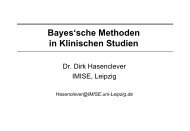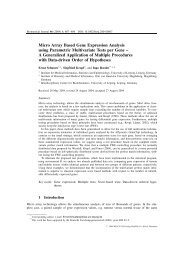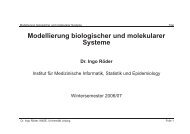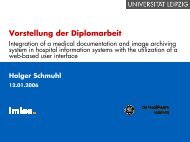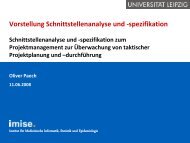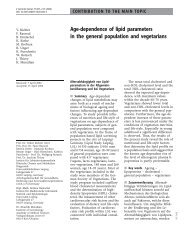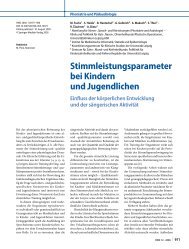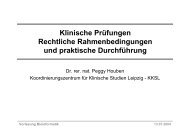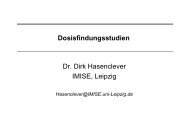Entropy Inference and the James-Stein Estimator, with Application to ...
Entropy Inference and the James-Stein Estimator, with Application to ...
Entropy Inference and the James-Stein Estimator, with Application to ...
You also want an ePaper? Increase the reach of your titles
YUMPU automatically turns print PDFs into web optimized ePapers that Google loves.
HAUSSER AND STRIMMER<br />
5. <strong>Application</strong> <strong>to</strong> Statistical Learning of Nonlinear Gene Association Networks<br />
In this section we illustrate how <strong>the</strong> shrinkage entropy estima<strong>to</strong>r can be applied <strong>to</strong> <strong>the</strong> problem of inferring<br />
regula<strong>to</strong>ry interactions between genes through estimating <strong>the</strong> nonlinear association network.<br />
5.1 From Linear <strong>to</strong> Nonlinear Gene Association Networks<br />
One of <strong>the</strong> aims of systems biology is <strong>to</strong> underst<strong>and</strong> <strong>the</strong> interactions among genes <strong>and</strong> <strong>the</strong>ir products<br />
underlying <strong>the</strong> molecular mechanisms of cellular function as well as how disrupting <strong>the</strong>se interactions<br />
may lead <strong>to</strong> different pathologies. To this end, an extensive literature on <strong>the</strong> problem of gene<br />
regula<strong>to</strong>ry network “reverse engineering” has developed in <strong>the</strong> past decade (Friedman, 2004). Starting<br />
from gene expression or proteomics data, different statistical learning procedures have been<br />
proposed <strong>to</strong> infer associations <strong>and</strong> dependencies among genes. Among many o<strong>the</strong>rs, methods have<br />
been proposed <strong>to</strong> enable <strong>the</strong> inference of large-scale correlation networks (Butte et al., 2000) <strong>and</strong><br />
of high-dimensional partial correlation graphs (Dobra et al., 2004; Schäfer <strong>and</strong> Strimmer, 2005a;<br />
Meinshausen <strong>and</strong> Bühlmann, 2006), for learning vec<strong>to</strong>r-au<strong>to</strong>regressive (Opgen-Rhein <strong>and</strong> Strimmer,<br />
2007a) <strong>and</strong> state space models (Rangel et al., 2004; Lähdesmäki <strong>and</strong> Shmulevich, 2008), <strong>and</strong><br />
<strong>to</strong> reconstruct directed “causal” interaction graphs (Kalisch <strong>and</strong> Bühlmann, 2007; Opgen-Rhein <strong>and</strong><br />
Strimmer, 2007b).<br />
The restriction <strong>to</strong> linear models in most of <strong>the</strong> literature is owed at least in part <strong>to</strong> <strong>the</strong> already<br />
substantial challenges involved in estimating linear high-dimensional dependency structures. However,<br />
cell biology offers numerous examples of threshold <strong>and</strong> saturation effects, suggesting that<br />
linear models may not be sufficient <strong>to</strong> model gene regulation <strong>and</strong> gene-gene interactions. In order<br />
<strong>to</strong> relax <strong>the</strong> linearity assumption <strong>and</strong> <strong>to</strong> capture nonlinear associations among genes, entropy-based<br />
network modeling was recently proposed in <strong>the</strong> form of <strong>the</strong> ARACNE (Margolin et al., 2006) <strong>and</strong><br />
MRNET (Meyer et al., 2007) algorithms.<br />
The starting point of <strong>the</strong>se two methods is <strong>to</strong> compute <strong>the</strong> mutual information MI(X,Y) for all<br />
pairs of genes X <strong>and</strong> Y , where X <strong>and</strong> Y represent <strong>the</strong> expression levels of <strong>the</strong> two genes for instance.<br />
The mutual information is <strong>the</strong> Kullback-Leibler distance from <strong>the</strong> joint probability density <strong>to</strong> <strong>the</strong><br />
product of <strong>the</strong> marginal probability densities:<br />
MI(X,Y) = E f(x,y)<br />
{<br />
log<br />
f(x,y) }<br />
. (7)<br />
f(x) f(y)<br />
The mutual information (MI) is always non-negative, symmetric, <strong>and</strong> equals zero only if X <strong>and</strong> Y<br />
are independent. For normally distributed variables <strong>the</strong> mutual information is closely related <strong>to</strong> <strong>the</strong><br />
usual Pearson correlation,<br />
MI(X,Y) = − 1 2 log(1 − ρ2 ).<br />
Therefore, mutual information is a natural measure of <strong>the</strong> association between genes, regardless<br />
whe<strong>the</strong>r linear or nonlinear in nature.<br />
5.2 Estimation of Mutual Information<br />
To construct an entropy network, we first need <strong>to</strong> estimate mutual information for all pairs of genes.<br />
The entropy representation<br />
MI(X,Y) = H(X)+H(Y) − H(X,Y), (8)<br />
1476



